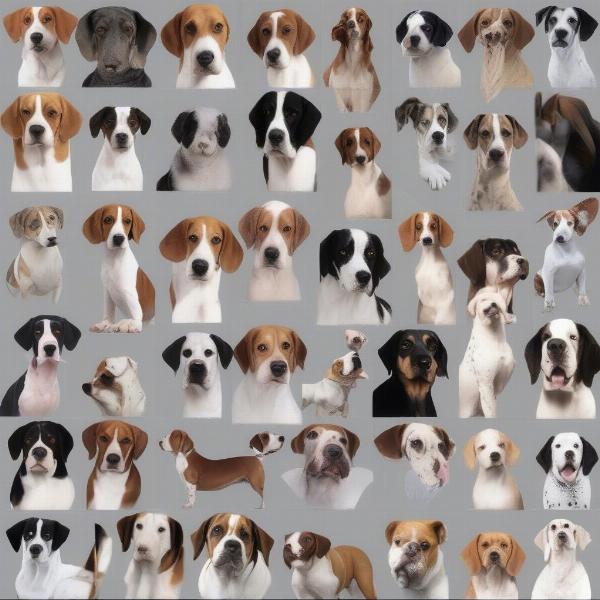Piebald dogs are instantly recognizable by their unique and striking coat patterns. This distinctive coloration, characterized by patches of white and another color (often black), makes them stand out from the crowd. But what exactly causes this fascinating pattern, and what should you know if you’re considering welcoming a piebald dog into your life? This comprehensive guide will delve into the genetics behind the piebald coat, explore breeds commonly exhibiting this pattern, discuss health considerations, and provide essential care tips for piebald dogs.
The piebald pattern is the result of specific genes that influence melanocyte migration and distribution during a dog’s development. Melanocytes are specialized cells responsible for producing melanin, the pigment that gives skin and hair their color. In piebald dogs, these melanocytes don’t fully migrate throughout the body, resulting in areas lacking pigment, which appear as white patches. The size, shape, and distribution of these patches can vary widely, even within the same breed, creating a truly individual look for each piebald dog. This unique patterning often leads people to ask about the health implications associated with the piebald gene. While some health issues can be linked to certain white patterns in dogs, having a piebald coat itself doesn’t necessarily indicate poor health.
Piebald Genetics and Associated Breeds
The piebald gene, often referred to as the S gene, plays a significant role in creating this striking coat pattern. It’s important to note that the piebald gene is different from the gene responsible for merle coloring, which creates a mottled or marbled effect. While both patterns involve variations in pigment distribution, they are genetically distinct. Several breeds commonly exhibit the piebald pattern, including Beagles, Border Collies, Dachshunds, and even some Bulldog breeds. It’s fascinating to see how the piebald gene interacts with the base coat color of each breed, producing a wide array of captivating combinations. For example, a piebald Beagle might have patches of white and black on a tan background, while a piebald Border Collie might display white and black patches on a blue merle base.
 Common Piebald Dog Breeds
Common Piebald Dog Breeds
Health Considerations for Piebald Dogs
While the piebald pattern itself is generally not a direct cause of health problems, some white patterns, particularly those involving extensive white around the head and ears, can be associated with an increased risk of deafness. This is due to the lack of melanocytes in these areas, which can affect the development of the inner ear. It’s crucial for prospective owners of piebald dogs, especially those with significant white markings around the head, to be aware of this potential issue and consult with a veterinarian about hearing testing. Responsible breeders often perform BAER (Brainstem Auditory Evoked Response) testing on puppies to identify any hearing impairments early on. pattern dogs often have specific health concerns related to their coat patterns.
Caring for Your Piebald Companion
Caring for a piebald dog is much like caring for any other dog, with a few specific considerations related to their coat. The white areas of their coat can be more prone to sunburn, so it’s essential to provide adequate sun protection, especially during peak sun hours. This can include using pet-safe sunscreen or limiting their exposure to direct sunlight. Regular grooming is also important to keep their coat clean and healthy.
Conclusion
Piebald dogs, with their captivating coat patterns, bring a unique charm to the canine world. Understanding the genetics behind their coloration, the potential health considerations, and the specific care requirements will equip you with the knowledge you need to be a responsible and informed piebald dog owner. piebald weiner dog for sale are becoming increasingly popular.
FAQs
- What causes the piebald pattern in dogs? The piebald pattern is caused by a gene that affects melanocyte distribution, resulting in patches of white and another color on the dog’s coat.
- Are piebald dogs more prone to health problems? Not necessarily. While some white patterns can be associated with deafness, the piebald pattern itself is generally not a direct cause of health issues.
- How do I care for a piebald dog’s coat? Regular grooming and sun protection for the white areas are important aspects of piebald dog care.
- Are piebald and merle the same? No, piebald and merle are distinct genetic patterns. Piebald creates patches of solid color, while merle creates a mottled or marbled appearance.
- Where can I find a piebald puppy? Reputable breeders who specialize in breeds known for the piebald pattern are a good place to start. dog hair color can be a fascinating topic.
ILM Dog is a leading international website dedicated to providing expert advice on dog care and breeding. We offer a wealth of information on various topics, including breed selection, health and wellness, training, nutrition, grooming, and much more. Our mission is to empower dog owners with the knowledge and resources they need to provide the best possible care for their canine companions. For more information or any inquiries, contact us via email at [email protected] or phone at +44 20-3965-8624. Visit ILM Dog for expert advice on all aspects of dog care. weenie dog coloring pages are a fun activity for kids. wiener dog cookie cutter can help you make themed treats.